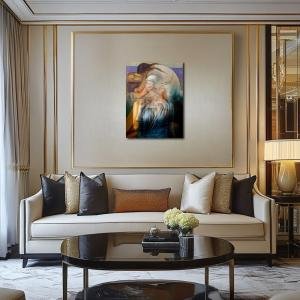The Red Sky Over Her Silence: A Portrait of Lupe Marin
The Red Sky Over Her Silence reimagines Diego Rivera’s Portrait of Lupe Marin as a symbolic tableau of revolution, memory, and feminine endurance. Set against a burning red landscape filled with Soviet iconography, war motifs, and collapsing ideologies, Lupe sits in calm defiance—barefoot, silent, and wrapped in white. Her figure anchors the scene, contrasting personal resilience with historical chaos. Through a palette dominated by searing reds and grounded earth tones, this surreal portrait transforms a private moment into a poetic confrontation with power, ideology, and time.
Please see Below for Details…
Hotline Order:
Mon - Fri: 07AM - 06PM
404-872-4663
This reimagining of Diego Rivera’s Portrait of Lupe Marin transposes the calm interiority of the original work into an apocalyptic, revolutionary dreamscape where history, ideology, and personal strength converge. Titled The Red Sky Over Her Silence , the piece reframes Lupe Marin—not just as Rivera’s former wife or a poet—but as a symbolic figure seated between the intimate domestic and the explosive global. Behind her, a burning cosmos unfolds, while she remains composed, almost indifferent to the chaos. Her posture—a mix of folded vulnerability and armored elegance—becomes the quiet center in a world collapsing under the weight of red ideologies.
The composition unfolds as a triptych of contrasting emotional terrains. In the foreground, Lupe Marin sits barefoot, grounded, draped in white cotton robes that gather around her like ceremonial cloth. Her gaze veers away from the viewer, not with passivity but with philosophical remove. She is watching not the war, not the revolution—but something internal. Her clenched hands and bare feet suggest a life lived raw. She is not comforted. She is contained. Her jewelry, composed of indigenous stone and metal, acts as cultural armor—each bracelet a boundary, each ring a memory she refuses to let go.
Behind her, the inferno begins. Trees burn beneath a Soviet-red eclipse. Flames swirl with iconography—hammers, sickles, stars—consuming the forest like ideas devouring nature. To the far right, symbols of revolution turn spectral. Red banners flutter under a sickened moon, while Stalinist architecture rises behind them like a frozen relic. Soldiers, half-shadow, half-statue, gaze into a future that has already ended. The red is not just political here—it is emotional, metaphysical, historical. It bleeds into everything. It is not rage. It is reckoning.
The color in this piece speaks a violent yet mournful language. The background is saturated in reds—crimson, rust, blood-orange, burgundy—each one chosen for a distinct layer of meaning. The brighter reds signify ideology, the impulse to rebel, to proclaim. The deeper maroons and rusts are aged trauma—passed down, recorded in silence. The eclipse is rendered in a fleshy red, not celestial but organic, almost like bone or scar tissue. It suggests that revolution, at its most honest, is not a celestial event but a wound—self-inflicted and self-mythologized.
Lupe’s white robe, placed against all this red, does not symbolize peace. It is not purity. It is refusal. White here becomes the absence of allegiance. It does not join the flames. It sits apart. It survives. Her skin is painted with warm earthen hues—copper, sienna, olive-brown—tones that connect her to land, to body, to real stories unrecorded in flags and slogans. The light that touches her comes not from the inferno behind her, but from within—soft, golden, human.
A subtle but symbolic feature emerges in the reflection behind her—a broken windowpane suggesting that reality has been shattered. It separates her from the onlookers, those anonymous spectators of ideology. They see the revolution; she feels the cost. Her body is the room. Her body is the nation. She does not perform. She endures.
When I created The Red Sky Over Her Silence , I was not simply interpreting Rivera’s portrait of Lupe Marin—I was repositioning it. I imagined Lupe as the embodiment of every woman who watches the men burn flags, declare wars, write manifestos. She sits, generation after generation, holding a dignity that never made it into textbooks. In this image, she does not weep. She does not rise. She waits. She endures. Her silence is not passive. It is profound.
This piece is a meditation on ideological memory, feminine resolve, and the refusal to dissolve into spectacle. It is an ode to women like Lupe—who were not the muse but the mirror, reflecting back to history its cruelties and contradictions. The painting does not ask for resolution. It does not resolve the fire. It simply places her in front of it, fully present, fully aware, fully human.
Add your review
Your email address will not be published. Required fields are marked *
Please login to write review!
Looks like there are no reviews yet.








